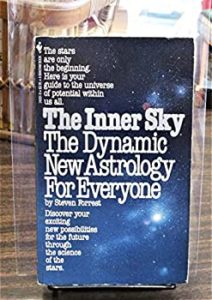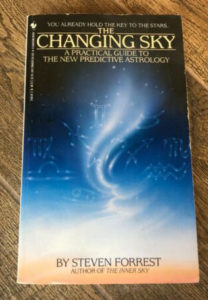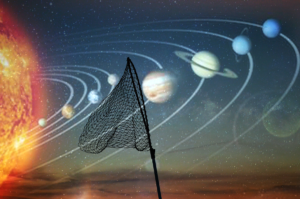Forty Years Ago...
Master’s Musings, May 2022
Not long from now, some of you will be advancing to FCEA-302. There, in Module 7, we explore the mysterious Venus Pentangle – how every 584 days, a retrograde Venus lines up with the Sun, and how if you plot the sign positions of five of those consecutive “inferior conjunctions,” you’ll see an almost perfect pentangle. It’s one of those tears-in-your-eyes miracles of astrology. I also write about it in Chapter 21 of The Book of Air too, in case you want a preview.
That cycle of five inferior Sun-Venus conjunctions takes almost eight years to complete – actually just two days plus eight hours short of eight years. Repeat it five times, and you’ve got forty years – plus the cycle returns to its starting point.
Bottom line: transiting Venus, even though it’s one of our fast-moving “trigger” planets, also presents us with an eight-year cycle and a forty-year cycle. Five pentangles repeated five times – five times eight years – and we hit reboot and the cycle starts all over again. Anyone can see it’s amazing, but what might it signify?
Of all the courses we’ve created, in many ways that Venus module in FCEA-302 lies closest to my heart. Here’s why. I really don’t know what it means. I have some ideas. They work meaningfully for me personally. In that Venus Pentangle module you’ll be getting to, I present my thoughts and my own hypotheses – but I invite you to explore this strangely beautiful, totally mysterious cycle yourselves. I’m sure that as we put our heads together, I will learn from you. By the time any one of you reaches the 300 courses, you’re getting pretty experienced as an astrologer. I think of you more as a colleague than as a student.
I do find it intriguing that even though these Venus cycles have been known for a long time, I’ve never read anything about them that really spoke to my heart. There are no doubt major discoveries and insights that remain hidden.

Welcome to May 2022. Forty years ago – one complete “five times five” cycle of Venus – I was busy writing The Inner Sky. Bantam Books had given me the contract and half of my $10,000 advance in August 1981. That was on the strength of a single sample chapter and some fast talking. A few months later, I was earnestly engaged in tapping out the complete text on a manual typewriter. A ream of paper was slowly being transformed into a book manuscript. That was forty years ago – so whatever Venusian seeds were planted then are getting a reboot now. As you get to FCEA302, you’ll see what I mean – that you can “connect the dots” in your life in a very meaningful way by counting out eight-year and forty-year intervals. The eight-year ones are easier to wrap your head around, of course – but forty years completes some kind of mega-cycle.
Here’s the proof of the pudding. We can easily trace the roots of the Forrest Center for Evolutionary Astrology to a 33 year old guy banging away on a manual typewriter in North Carolina in 1982. The publication of The Inner Sky set wheels turning in my life in big ways, both personally and publicly. It doesn’t strain the imagination very much to see a kind of seed-to-flower relationship between me writing my first book and the current emergence of the school. Astrology works in a mechanical way like that, but it also works in deeper ways. So let’s be careful here . . .
There is a natural tendency when we think of cycles to think of repeating patterns – of “history repeating itself.” That’s ultimately a pretty depressing way of viewing life. It’s as if history teaches us nothing – which actually often appears to be the case at a world-history level. Let’s just hope it’s not always the case at a personal level. Even for individuals, the metaphor of the endlessly circling merry-go-round can be sadly accurate sometimes, but only if people miss the point of having experience in the first place. Experience should teach us something. We should be wiser – and thus different – for it. If we get a second look at the same thing, maybe we can react in an unprecedented and creative way. Maybe we’ve learned something from our mistakes. Maybe we can do better.
Let’s replace the cyclical metaphor of the merry-go-round with a helix – like an ascending corkscrew. Hopefully, we are not just going ‘round and ‘round – hopefully, we are also going higher and higher.
Here are some examples of exactly that kind of evolution as my own helix completes a 40 year Venus cycle. Watch a pile of typing paper forty years ago morph into an international online school today.
Example #1
In The Inner Sky, you read that the Ascendant is the “mask we wear.” That’s not a bad way of expressing it, but the trouble is that a mask hides a face and that’s not exactly what the Ascendant does. So you’ll read “mask” in those pages, but in later books, in the videos I’ve made for the school, and in our Q&A sessions, you’ll more often hear me speak of the Ascendant as the “stained glass through which the light of the soul is shining.” That’s a more accurate metaphor – and I fervently wish that I had thought of it forty years ago when I was writing that book!
Live and learn – and isn’t that the point? Please know that as a student in the FCEA, as you read my books, you’re exposed to a shifting landscape. You have my thinking today, plus my thinking forty years ago, plus all the steps in between. Naturally, you will find some inconsistencies. Hallelujah! If there were none, it would mean that I had learned nothing in four decades.
Example #2
In the Pluto section of The Inner Sky, you’ll read a lot about destiny and finding meaning in your life. I still believe all of that, but I think I’ve probably learned more about Pluto over the past forty years than I have about any other planet. Back then, I still had not fully grasped the nature of the intense inner work Pluto requires – facing our innate woundedness and all of that. I don’t need to repeat it here because you’re hearing plenty about it in courses you are taking. The point is that I didn’t know it when I was writing The Inner Sky, so it’s not there in those pages. I regret that omission. I know it now, but it’s too late to put it in a book that’s already written. Like you, I am a work in progress.
Example #3
In The Inner Sky, I called Pisces “the Face Dancer.” That’s an image taken from the then-popular book, Dune, by Frank Herbert. “Face Dancers” were a race of people who could take on anyone else’s appearance – and that nicely encapsulated one dimension of the sign Pisces. The metaphor worked like crazy for a few years. But then Dune sort of faded from public attention and soon I was spending a lot of time answering emails about what I meant by “Face Dancer.”
Using that culturally-transitory term was a rookie mistake on my part. I’ve learned not to do that in my writing anymore. That’s why in my subsequent books and articles, you won’t see words like “chicks and dudes” or the more current “do you feel me” – or “dope” or LOL, OMG, or TTYL. That kind of language may be the cat’s pajamas today and old hat tomorrow – and that sentence sure was fun to write.
Of course, Dune is now back in the form of the Denis Villeneuve film, so maybe my use of Face Dancer will get a lucky reprieve for a few years. Whatever its fate, the term is hard-wired into those unforgiving pages and I have to live with the consequences.
Example #4
In The Inner Sky, I called Sagittarius “the Gypsy.” I’ve occasionally gotten some grief for that, as if I’d somehow insulted Roma people by using the term. Given the folkloric implications of the word “gypsy,” especially here in the USA, it works like crazy for conveying at least one dimension of the spirit of Sagittarius. To me, using the word “gypsy” in this context doesn’t seem any more insulting than . . . well, calling someone a Sagittarian. But people are sensitized now, and I frequently find myself trying to use more neutral terms, such as “voyager” or “traveler.”
No writer wants to write “plain Vanilla” language, but we all have to pick our battles.
Despite growing up in the times I did, I think I’ve been relatively clean when it comes to racism, sexism, and homophobia. I don’t think there are instances of any of those toxins in the pages of The Inner Sky or any of my other books. I thank divine guidance for that. How would you like to have everything you said forty years ago a matter of public record? The printed page, once printed, does not change or update itself. It is unforgiving.
I used the term “evolutionary astrology” several times in The Inner Sky. My editor at Bantam wanted me to “soft-pedal the spiritual stuff,” but I was already working with the lunar nodes and reincarnation in those days. I snuck a bit of that into the material about John Lennon. He was “the warrior who lost the war,” with his Aries south node in the 12th house. I’m glad it’s there, but I wish there were more of it.
Naturally, back in my salad days, I was working with transits, progressions, and solar arcs. The Inner Sky just wasn’t about them. My thinking about these moving points was already pretty well-established, but I didn’t go to print with it until The Changing Sky in 1986. As you read that book, you’ll also see that I was finally beginning to get clearer about the function of Pluto. I still feel good about what’s in those pages, but there is one big feature of The Changing Sky that has come back to haunt me right here today in the FCEA. That’s The Four Nets. I probably get more questions and requests for clarification about that system than about any other single topic in the entire curriculum of the school.
As you know, the Four Nets were an attempt to establish a kind of formal hierarchy of importance among all the possible transits, progressions, and solar arcs. Without some kind of system, they quickly become overwhelmingly chaotic. In the FCEA, we always emphasize a “first things first” approach – but for people learning the system, knowing how to weigh transiting Saturn conjunct the Sun versus progressed Mars squaring the Ascendant isn’t intuitively obvious. Hence: the Four Nets – they are a rote and mechanical way of at least defining four basic “bins” based on the relative importance of various configurations Those bins come packaged with a big “thou shalt not:” do not worry about the second bin until you’ve gotten the stuff in the first bin figured out.
All in all, I think the Four Nets work pretty well. I think they have proven helpful. But when I was first formulating them back in 1984 and 1985, I still had a lot to learn. Back then, I didn’t fully grasp the importance of the progressed lunar cycle, for example – but a progressed New Moon can stand your life on its head. It’s Net One material, for sure! I didn’t grasp the significance of declination either.
Over the years, The Changing Sky came out in several editions and the Nets were always getting tweaked. Once the book was in its final form by about 1998, I continued to learn. Various handouts of The Four Nets were created over the twenty years or so of my Apprenticeship Program, all of them slightly different.
On top of all of that, there is the practical problem of trying to get the Four Nets to fit on one page. If you set out to make a simple, clear guideline, then you start over-complicating it, you’ve defeated your own purpose. That’s tough because there are so many nuances to deal with. For example, we read Net One, #3 – “Any progressed planet or Angle (except the Moon) conjunct, square, or opposed to the natal Ascendant, Midheaven, Sun, or Moon.”
That’s already a mouthful! But by “any progressed planet,” I actually meant any planet that we in fact use in progressions – so no progressed Jupiter, Saturn, Uranus, Neptune, or Pluto. That point is clear enough in the text of The Changing Sky, so I didn’t clutter the Four Nets with it. Maybe I should have – we’ve had a lot of questions about it.
The real problem is that The Four Nets are only a guideline, nothing more. They’re kind of like training wheels on your bicycle. They’ll keep you in balance until you learn to ride. And “learning to ride” with transits, progressions, and arcs really depends on gauging the individual power of each planet – with Gemini rising, those Mercury progressions pack more punch than if you have Taurus rising, for example. Lunar people react more strongly to the Moon than do Mercurial people.




